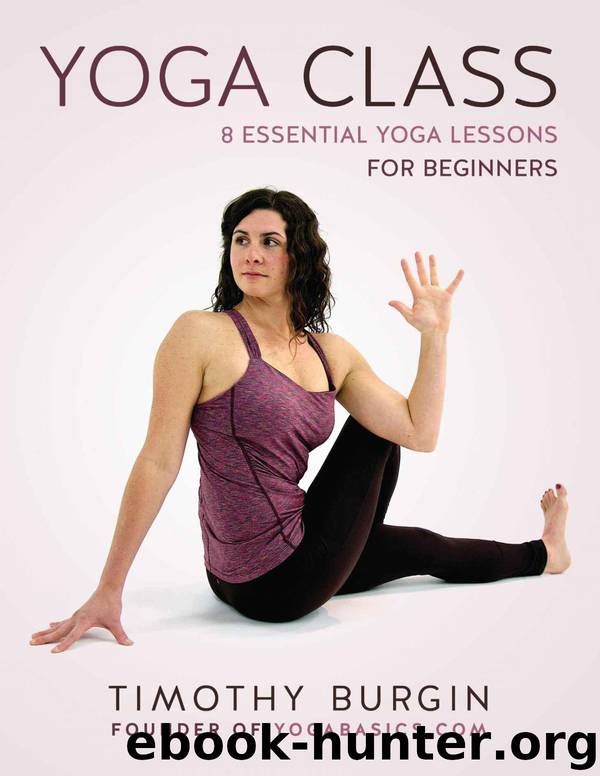Yoga Class: 8 Essential Yoga Lessons for Beginners by Burgin Timothy

Author:Burgin, Timothy [Burgin, Timothy]
Language: eng
Format: epub
Tags: Health, Mind & Body
Publisher: Adhimukti Press
Published: 2014-09-04T21:00:00+00:00
Benefits: Knee down twist stretches the back muscles, realigns and lengthens the spine, and hydrates the spinal disks.
Contraindications: Recent or chronic injury to the knees, hips or back.
Modifications: Place a folded blanket under the bent knee to support it.
Variations: Rest the left hand on the bent knee, adding more weight for gravity to gently pull the knee down.
Lesson Five
The Yoga Scientist
Swadyaya: self-observation & self-inquiry
The practice of yoga is often referred to as a science of personal inquiry. While yogic techniques have been developed over many centuries by millions of yogis, students must practice in order to determine if these yogic concepts, philosophies, and practices are appropriate for them. To be able to know if something works, students need to practice Swadyaya, which translates as “self-study.” Swadyaya is the ability to observe and witness your thoughts, feelings, emotions and sensations as separate from your Self.
Consciously witnessing what arises within is essential to creating objectivity, without which we lose our discernment or ability to judge if the yoga practices work and ring true to us. There are many different terms describing how to achieve swadyaya, including self-observation, self-inquiry, and mindfulness, but overall, the technique of swadyaya is simple: step back and observe yourself. However, the practice is difficult and requires constancy and diligence since the mind is endlessly fascinated with its own projections, creations, and thoughts.
An easy way to begin practicing swadyaya is to ask yourself one or more inquiry questions while practicing yoga. In this lesson’s new poses I’ve listed a specific inquiry question to help direct your attention inwards and encourage you to observe what is happening. Here are a few general example questions you can practice in any yoga pose:
• How can I be more present in this moment?
• How is this yoga pose different than the last?
• How can I deepen my experience in this moment?
• Am I breathing slowly and deeply in this pose?
Playing the role of the witnessing yoga scientist not only gives us the ability to validate yogic techniques and practices, but allows us to uncover and transcend our ingrained and unconscious thoughts, behaviors, and patterns. When we take swadyaya to this depth, it is important to be compassionate and have an open and accepting attitude towards ourselves and our limitations.
Download
This site does not store any files on its server. We only index and link to content provided by other sites. Please contact the content providers to delete copyright contents if any and email us, we'll remove relevant links or contents immediately.
Tools of Titans by Timothy Ferriss(7815)
Bodyweight Strength Training by Jay Cardiello(7676)
Born to Run: by Christopher McDougall(6895)
Inner Engineering: A Yogi's Guide to Joy by Sadhguru(6441)
Asking the Right Questions: A Guide to Critical Thinking by M. Neil Browne & Stuart M. Keeley(5357)
The Fat Loss Plan by Joe Wicks(4622)
Bodyweight Strength Training Anatomy by Bret Contreras(4472)
Yoga Anatomy by Kaminoff Leslie(4103)
Science and Development of Muscle Hypertrophy by Brad Schoenfeld(3971)
Dynamic Alignment Through Imagery by Eric Franklin(3920)
ACSM's Complete Guide to Fitness & Health by ACSM(3824)
The Four-Pack Revolution by Chael Sonnen & Ryan Parsons(3795)
Exercise Technique Manual for Resistance Training by National Strength & Conditioning Association(3788)
Bodyweight Strength Training: 12 Weeks to Build Muscle and Burn Fat by Jay Cardiello(3781)
Yoga Anatomy by Leslie Kaminoff & Amy Matthews(3740)
The Ultimate Bodybuilding Cookbook by Kendall Lou Schmidt(3708)
Yoga Therapy by Mark Stephens(3574)
Nutrition for Sport, Exercise, and Health by Spano Marie & Kruskall Laura & Thomas D. Travis(3556)
Nutrition for Sport, Exercise, and Health by Marie Spano & Laura Kruskall & D. Travis Thomas(3548)
